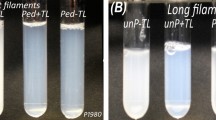Summary
Microfilaments in the myoid cells of the peritubular tissue in the mouse, swine and human testis bind heavy meromyosin (HMM) and form arrowhead complexes. The periodicity of the arrowhead complexes is about 35 nm. Individual filaments show arrowheads that point in the same direction. Opposing polarity of the HMM-bound filaments is also observed. The microfilaments do not bind HMM in the presence of 10 mM ATP. After treatment with the contraction medium of Hoffmann-Berling, the filaments appear to be undulated. These observations indicate that the microfilaments in the myoid cell are actin-like in nature. A small number of thicker filaments (about 10 nm in diameter) which do not bind HMM is also observed in the cell. Microfibrils which have been reported around the human myoid cell are also found in the swine.
Similar content being viewed by others
References
Böck, P., Breitenecker, G., Lunglmayer, G.: Kontraktile Fibroblasten (Myofibroblasten) in der Lamina propria der Hodenkanälchen vom Menschen. Z. Zellforsch. 133, 519–527 (1972)
Bressler, R.S., Ross, M.H.: Differentiation of peritubular myoid cells of the testis: Effects of intratesticular implantation of newborn mouse testes into normal and hypophysectomized adults. Biol. Reprod. 6, 148–159 (1972)
Bustos-Obregón, E., Holstein, A.F.: On structural patterns of the lamina propria of human seminiferous tubules. Z. Zellforsch. 141, 413–425 (1973)
Clermont, Y.: Contractile elements in the limiting membrane of the seminiferous tubules of the rat. Exp. Cell Res. 15, 438–440 (1958)
Connell, C.J., Christensen, K.A.: The ultrastructure of the canine testicular interstitial tissue. Biol. Reprod. 12, 368–382 (1975)
Dierichs, D., Wrobel, K.H.: Lichtund elektronenmikroskopische Untersuchungen an den peritubulären Zellen des Schweinehodens während der postnatalen Entwicklung. Z. Anat. Entwickl.-Gesch. 143, 49–64 (1973)
Dym, M.: The fine structure of the monkey (Macaco) Sertoli cell and its role in maintaining the blood-testis barrier. Anat. Rec. 175, 639–656 (1973)
Dym, M., Fawcett, D.W.: The blood-testis barrier in the rat and the physiological compartmentation of the seminiferous epithelium. Biol. Reprod. 3, 308–326 (1970)
Fawcett, D.W., Heidger, P.M., Leak, L.V.: Lymph vascular system of the interstitial tissue of the testis as revealed by electron microscopy. J. Reprod. Fertil. 19, 109–119 (1969)
Fawcett, D.W., Leak, L.V., Heidger, P.M.: Electron microscopic observations on the structural components of the blood-testis barrier. J. Reprod. Fertil., Suppl. 10, 105–122 (1970)
Gardner, P.J., Holyoke, E.A.: Fine structure of the seminiferous tubule of the Swiss mouse. I. The limiting membrane, Sertoli cell, spermatogonia, and spermatocytes. Anat. Rec. 150, 391–404 (1964)
Hoffmann-Berling, H.: Adenosintriphosphat als Betriebsstoff von Zellbewegungen. Biochim. biophys. Acta (Amst.) 14, 182–194 (1954)
Huxley, H.E.: Electron microscope studies on the structure of natural and synthetic protein filaments from striated muscle. J. molec. Biol. 7, 281–308 (1963)
Ishikawa, H.: Arrowhead complexes in a variety of cell types. In: Exploratory concepts in muscular dystrophy II (A.T. Milhorat, ed.). Amsterdam: Excerpta Medica 1973
Ishikawa, H., Bischoff, R., Holtzer, H.: Formation of arrowhead complexes with heavy meromyosin in a variety of cell types. J. Cell Biol. 43, 312–328 (1969)
Kagayama, M., Irisawa, S., Shirai, M., Matsushita, K.: Contractile cells in the boundary tissue of seminiferous tubules. Jap. J. Urol. 56, 842–847 (1965)
Komnick, H., Stockem, W., Wohlfarth-Bottermann, K.E.: Cell motility: Mechanism in protoplasmic streaming and ameboid movement. Int. Rev. Cytol. 34, 169–249 (1973)
Kretser, D.M. de, Kerr, J.B., Paulsen, C.A.: The peritubular tissue in the normal and pathological human testis. An ultrastructural study. Biol. Reprod. 12, 317–324 (1975)
Lacy, E., Rotblat, J.: Study of normal and irradiated boundary tissue of the seminiferous tubules of the rat. Exp. Cell Res. 21, 49–70 (1960)
Leeson, C.R.: An electron microscopic study of cryptorchid and scrotal human testis, with special reference to pubertal maturation. Invest. Urol. 3, 498–511 (1966)
Leeson, C.R., Leeson, T.S.: The postnatal development and differentiation of the boundary tissue of the seminiferous tubule of the rat. Anat. Rec. 147, 243–260 (1963)
Roosen-Runge, E.C.: Motions of the seminiferous tubules of rat and dog. Anat, Rec. 109, 413 (1951)
Ross, M.H.: The fine structure and development of the peritubular contractile cell component in the seminiferous tubules of the mouse. Amer. J. Anat. 121, 523–558 (1967)
Ross, M.H., Long, I.R.: Contractile cells in human seminiferous tubules. Science 153, 1271–1273 (1966)
Schroeder, T.E.: Actin in dividing cells: Contractile ring filaments bind heavy meromyosin. Proc. nat. Acad. Sci. (Wash.) 70, 1688–1692 (1973)
Toyama, Y.: Actin-like filaments in the Sertoli cell junctional specializations in the swine and mouse testis. Anat. Rec. (in press)
Vitale, R., Fawcett, D.W., Dym, M.: The normal development of the blood-testis barrier and the effects of clomiphene and estrogen treatment. Anat. Rec. 176, 333–344 (1973)
Author information
Authors and Affiliations
Additional information
The author gratefully acknowledges Drs. Takashi Obinata for providing HMM and Takashi Katayama for providing the castrated human testes. He also thanks Drs. Toshio Nagano for his support and critical reading of the manuscript, Harunori Ishikawa for his helpful suggestions during the course of the study and Ernest F. Couch for assistance in the preparation of the manuscript
Rights and permissions
About this article
Cite this article
Toyama, Y. Actin-like filaments in the myoid cell of the testis. Cell Tissue Res. 177, 221–226 (1977). https://doi.org/10.1007/BF00221083
Accepted:
Issue Date:
DOI: https://doi.org/10.1007/BF00221083




